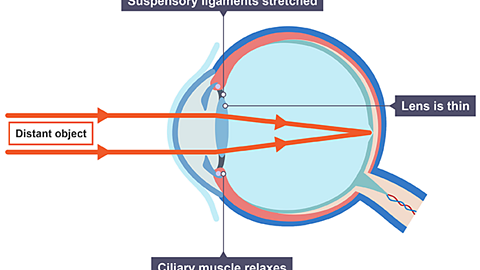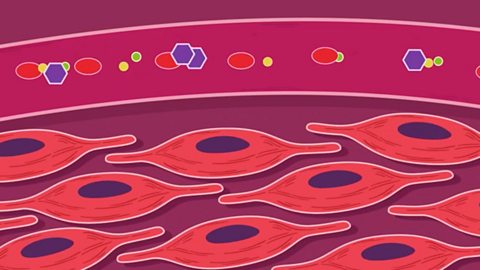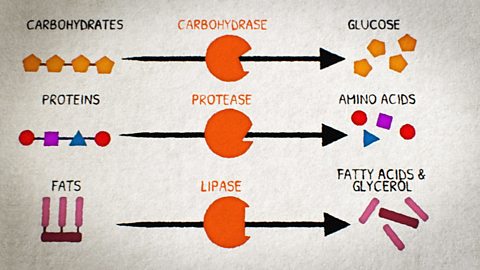What are the body's communication systems?
The human body has two communication systems that help us to respond to changes:
- nervous system
- hormonal system
Comparisons:
They both:
send messages around our body
enable the body to respond to stimuli
Differences:
| Nervous system | Hormonal system | |
|---|---|---|
| Speed | fast | slow |
| Nature of response | electrical impulses | hormones / chemicals |
| Pathway | travels by neurone | travels in blood |
| Target | effector - muscle or gland | organ |
| Type of response | involuntary or voluntary | always involuntary |
The nervous system
The brain and spinal cordThe part of central nervous system of a mammal which runs inside its backbone form the central nervous system (CNS).
The CNS controls and coordinates responses between receptorOrgan, tissue or cell that detects a stimulus. and effectorThe organ, tissue or cell that produces a response..
Stimuli are changes in our environment that we respond to and are detected by receptors.
Different receptors are sensitive to different stimuli (eg receptors in the eye are sensitive to light).
A nerve cell/neurone carries information in the form of nerve impulses from the receptor to thecoordinator.
The coordinator – brain or spinal cord – determines whether or not to respond to the stimulus.
A neurone carries information from the coordinatorThe central nervous system, it determines the correct response to a stimulus. to an effector.
An effector is a muscle or gland that can bring about a response.
| Sense Organ | Receptor | Stimuli Detected |
|---|---|---|
| Eye | light receptors | light |
| Ear | sound receptors | sound |
| Nose | chemical receptors | chemicals (smell) |
| Tongue | chemical receptors | chemicals (taste) |
| Skin | thermoreceptors | temperature (hot/cold) |
| Skin | pressure receptors | touch and pain |
The eye
Our eyes are specialised sense organs that contain receptorOrgan, tissue or cell that detects a stimulus. sensitive to light.
There are many parts that work together to produce a focused image on the retinaThe light-sensitive area on the back of the eye. Light must be focused on the retina in order to see clearly. under different light conditions.
| Structure | Function |
|---|---|
| Conjunctiva | Thin, transparent protective outer covering that prevents entry of microorganisms. |
| Cornea | Transparent part at front of eye that allows light to enter. It also causes slight bending/refraction of light. |
| Pupil | Space in the iris that allows light into the eye. |
| Iris | Controls how much light enters the eye by changing its diameter. |
| Lens | Bends/refracts light towards the retina. |
| Aqueous humour | Fluid in front of the lens that helps maintain the shape of the eye and lens. |
| Vitreous humour | Fluid behind the lens that helps maintain the shape of the eye and lens. It also keeps the retina against the wall of the eye. |
| Retina | Contains light sensitive receptor cells. |
| Optic nerve | Contains neurones that carry information from the eye to the brain. |
Focusing the eye
As light passes through the cornea some refraction takes place. More refractionThe bending of light as it passes from one substance into another (also happens with sound waves). occurs when the light passes through the lens.
The thickness of the lens can be adjusted in order to focus light on the retina.
When looking at a distant object the lens is thin as little adjustment is needed to focus light onto the retina.
When looking at nearby objects the lens is thick to provide additional refraction to focus light on the retina.

Image caption, Looking at a distant object

Image caption, Looking at a nearby object
1 of 2
Accommodation - the lens changing shape (Higher Tier)
The ciliary muscle is a circular ring of muscle around the lens, connected by suspensory ligaments.
These work together to allow our eyes to focus on objects at different distances.
Controlling the amount of light entering the eye
Too little or too much light can damage the light sensitive receptor cells in the retina.
In dim light, the pupil becomes larger to allow as much light as possible to enter.
In bright light, the pupil becomes smaller to restrict the amount of light entering.
Neurones
receptorOrgan, tissue or cell that detects a stimulus. and effectorThe organ, tissue or cell that produces a response. are connected to the central nervous system (CNS)The part of the nervous system made up of the brain and spinal cord. by neuroneNerve cells. They carry an electrical message or impulse when stimulated..
A neurone’s function is to transmitTo cause something to pass from one area to another. electrical impulses across the nervous system quickly.

A neurone is adapted for this function in the following ways:
The cell body contains the cytoplasmThe living substance inside a cell (not including the nucleus). and nucleusThe nucleus controls what happens inside the cell. Chromosomes are structures found in the nucleus of most cells. The plural of nucleus is nuclei. (the control centre of the cell).
The axon is a long extension of the cytoplasm (can be up to 1m). This means nerve impulses can be transmitted to the extremitiesThe furthest point of something, which in the body is the hands and feet. by one cell.
The myelin sheath is a fatty layer that surrounds the axon. The sheath acts as an insulator and speeds up nerve impulses.
The branched ends of the axon and the smaller branches coming from the cell body allow the neurone to make connections with many other neurones.
Synapses
A synapse is the gap between two neurones.
It functions as a junction because it links two neurones, allowing messages to pass between them and it also controls the direction of messages.
• When an impulse reaches the end of the axon, a transmitter chemical is released.
• This chemical diffusionThe random movement of a substance from a region of high concentration to a region of low concentration. across the gap.
• When in high enough concentration it triggers an electrical impulse in the next neurone, allowing the signal to continue.
Reflex actions
Voluntary actions require conscious thought and take more time due to thinking.
Reflex actions happen quickly without thinking, protecting the body from harm, for example, pulling your hand away from a hot surface.
Reflex arc
A reflex action is fast because it follows a short pathway with only three neurones and two synapses:
• Sensory neurone: carries impulse from the receptor to the spinal cord (coordinator).
• Association or relay neurone: connects the sensory neurone to the motor neurone.
• Motor neurone: sends impulses from the spinal cord to an effector (muscle or gland) to cause a response.
How much do you know about the nervous system?
More on Living processes
Find out more by working through a topic
- count6 of 6

- count1 of 6

- count2 of 6

- count3 of 6
